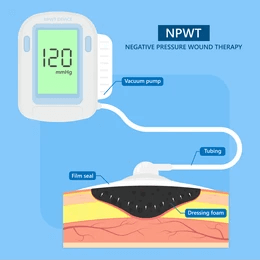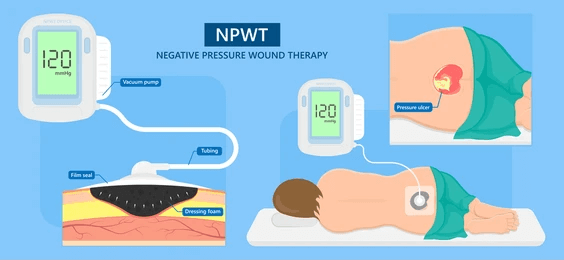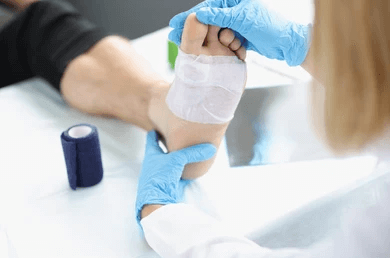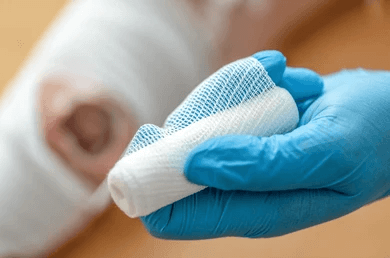Negative Pressure Wound Therapy
Home / What We Do /Negative Pressure Wound Therapy

Negative Pressure Wound Therapy at Spark Wound Care
At Spark Wound Care, we are committed to using the most advanced techniques to accelerate healing and improve patient outcomes. One of the cutting-edge treatments we offer is Negative Pressure Wound Therapy (NPWT), a highly effective method for managing complex wounds and promoting faster recovery.
What is Negative Pressure Wound Therapy?
Negative Pressure Wound Therapy (NPWT), also known as vacuum-assisted wound closure, is a non-invasive treatment that uses controlled suction to remove fluids, bacteria, and other contaminants from the wound. The therapy involves placing a sealed dressing over the wound and connecting it to a vacuum pump, which creates negative pressure. This negative pressure helps draw out excess fluids, reduces swelling, and promotes the formation of new tissue, ultimately speeding up the healing process.

How Does NPWT Work?
NPWT works by applying continuous or intermittent negative pressure to the wound site. Here’s how it helps in the healing process:

1. Removes Excess Fluid
Wounds often produce exudate, a fluid that can slow healing and increase the risk of infection. NPWT effectively removes this excess fluid, helping to keep the wound bed clean and reducing the likelihood of infection.

2. Promotes Tissue Regeneration
The negative pressure stimulates blood flow to the wound, providing oxygen and nutrients to the tissues, which are essential for healing. This increased circulation encourages the formation of healthy, granulated tissue, which is necessary for wound closure.

3. Reduces Swelling and Inflammation
By removing fluid and reducing pressure around the wound, NPWT helps to decrease inflammation, making the wound environment more conducive to healing.

4. Protects the Wound
The sealed dressing used in NPWT creates a barrier that shields the wound from external contaminants, reducing the risk of infection and preventing further damage.

Conditions Treated with NPWT
Negative Pressure Wound Therapy is highly effective for treating a variety of wounds, particularly those that are difficult to heal with traditional methods. Conditions that may benefit from NPWT include:
- Chronic wounds such as diabetic ulcers, pressure ulcers, and venous ulcers
- Surgical wounds that have reopened or are at risk of infection
- Traumatic wounds with significant tissue loss or damage
- Burns and other skin injuries that require enhanced healing
- Wounds with large amounts of exudate that require management
Benefits of Negative Pressure
Wound Therapy
Wound Therapy
NPWT offers several key benefits for patients dealing with complex or chronic wounds:

1. Faster Healing
By promoting tissue growth and reducing fluid buildup, NPWT can significantly shorten the healing time compared to traditional methods.

2. Reduced Infection Risk
The continuous removal of fluids and bacteria helps keep the wound clean, lowering the chance of infection

3. Less Frequent Dressing Changes
Because the dressing remains sealed and can be left in place for longer periods, patients typically experience less discomfort and fewer disruptions compared to traditional wound dressings.

4. Minimally Invasive
NPWT is a non-invasive treatment option that enhances the body’s natural healing process without the need for surgical intervention.
Is NPWT Right for You?
At Spark Wound Care, we evaluate each patient’s unique situation to determine the most appropriate treatment plan. NPWT is often recommended for patients whose wounds are slow to heal or who have underlying conditions that complicate the healing process, such as diabetes or vascular disease. However, it may not be suitable for all wounds, particularly if there is active infection, exposed blood vessels, or other specific contraindications.


What to Expect During NPWT
During your NPWT treatment, our skilled clinicians will apply a specialized dressing to the wound, which is then connected to the vacuum pump. The therapy may be continuous or intermittent, depending on the wound type and your specific needs. We will monitor your progress closely and adjust the treatment as needed to ensure optimal healing.
Most patients find NPWT to be a comfortable and effective treatment, though some may experience mild discomfort when the dressing is first applied or during dressing changes. Our team is dedicated to ensuring that you remain as comfortable as possible throughout your treatment.
Your Partner in Advanced Wound Care
At Spark Wound Care, we are proud to offer Negative Pressure Wound Therapy as part of our comprehensive wound care services. Whether you are dealing with a chronic wound or a recent injury, our team of experts is here to provide the most advanced treatments available, tailored to your individual needs.
Contact us today to learn more about NPWT and how we can help you heal faster, reduce complications, and regain your quality of life.